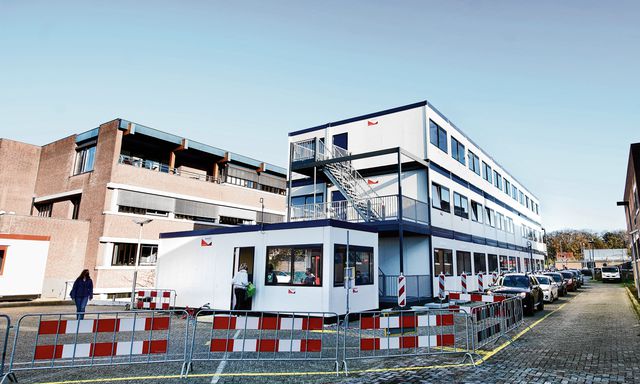
These are the lessons of the fourth wave to prevent the fifth wave
In the middle of summer, the battle plan to stop the fourth wave was ready. RIVM has worked on it, and the GGDs have developed a “Q3 Roadmap” for better employee deployment. But even before that plan was on the desk of outgoing minister Hugo de Jong (Public Health, CDA), the wave had already started — and there was no time to stop it.
The plan looked like this. This summer, just like last year, the number of infections should have fallen sharply – to a maximum of a few dozen positive tests per day.
Then the new outbreaks will be and remain local. Virus outbreaks can be quickly detected by measurements in sewage – infected people excrete virus particles in their faeces. Then the GGDs dive right over this neighborhood: everyone will receive an invitation to be tested and an extensive search for undetected infections will have to be carried out. Source and contact investigation must be able to link each patient to a known source of infection.
But that plan was based on the fourth wave in the fall, not in July. The Cabinet had recently decided to allow nightclubs to open their doors again, and festivals were allowed again. It was possible, he thought, because visitors would be tested for access. But it turns out there are major loopholes in this system to prevent outbreaks. Even before the plan to prevent a new wave was implemented, the number of infections increased rapidly.
Late results
There were also problems with important parts of the plan: An increase in the number of virus particles in sewage was detected only after the number of positive tests actually exploded. The delay was due to the fact that this search takes a relatively long time. Another problem was that people tested sometimes had to wait a long time to get their results due to busy labs. Source and contact investigations soon had to be restricted due to the inability of the GGDs to handle the large influx of infected persons.
Will the battle plan for fall be enough, when the respiratory infection season begins again, life indoors occurs more often and the virus spreads more easily?
The plan is good, says Susan van den Hove, head of the Center for Epidemiology and Infectious Disease Control at the National Institute of Public Health, but it was not appropriate for the summer situation. RIVM believes that during the next wave the number of infections will be very low and there will be a local outbreak. “They can be seen faster in the sewers, because then you also take people who haven’t been tested themselves with you. If there are only local outbreaks, then the GGDs should be able to handle the investigation.”
Read also: GGD says: ‘Drying the virus away with source and contact research is no longer realistic’
technology leap
There is also hope that new working methods will speed up communication investigations. There is already an example of this. Because one GGD hardly had to limit the source and contact this summer’s research. In the GGD district of Utrecht, investigations were carried out almost completely and about 1,300 ‘cases’ were handled per day. “Given the experience of last year, when the number of infections suddenly increased dramatically, we decided to innovate this process,” a company spokesperson explains.
Utrecht GGD works with a digital system, Coronacare. Young people under the age of thirty – the most affected people in the last wave – were called once and asked to complete an online questionnaire about where they had been and with whom they had been in contact. This is how GGD and RIVM monitor sources of infection. While the source and researchers provided the connection, the elderly and other at-risk groups can be called “We have noted that this digital process is a very effective method and suitable for the target group.
This fall, all GGDs should take a technology leap. HPZone, the old software that GGDs currently use to find source and contacts, will then be replaced by its own system. Using an app, GGD Contact, people who test positive can take an inventory of who they were close to during the contagious period. Their contact details can be shared with GGD via the app, which is expected to save a lot of time. All GGDs must use the new system before the end of September.
Read more about the source and contact investigation issues: Nothing to do for GGD’s resilient workers, in the midst of an epidemic
Vaccination rate
How successful the plan is in stopping a potential fifth wave will depend in large part on vaccination coverage. Van den Hoof: “Now we’ve seen again how quickly the virus can spread among non-vaccinated groups.”
Parties at nightclubs and festivals may be allowed again if vaccination rates are higher. Access testing rules have already been tightened: the lifespan of a negative test can be up to 24 hours, instead of 40. But, van den Hoof warns: Vaccines appear to protect less well than the delta variant. “You have to think seriously about how the festivals are organized. Perhaps the vaccinated people should have been tested before they were allowed in as long as not everyone had a chance to get fully vaccinated.” Many young people were vaccinated only once.
The peak of the fourth wave also showed good news: the infected young people infected a minority of the elderly. “The vast majority of seriously ill people have not been vaccinated,” van den Hoof adds. “There were also more positive tests in nursing homes, but that increase was nothing compared to what we’ve already seen. This is encouraging, because most infections were really caused by the delta variant at the time.”
A version of this article also appeared on NRC on the morning of August 11, 2021

“Travel enthusiast. Alcohol lover. Friendly entrepreneur. Coffeeaholic. Award-winning writer.”

